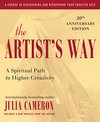
Saved by Lael Johnson and
The Artist's Way: 25th Anniversary Edition

Saved by Lael Johnson and
To live a creative life, we must lose our fear of being wrong. JOSEPH CHILTON PEARCE
We meditate to discover our own identity, our right place in the scheme of the universe. Through meditation, we acquire and eventually acknowledge our connection to an inner power source that has the ability to transform our outer world. In other words, meditation gives us not only the light of insight but also the power for expansive change.
Artists love other artists. Shadow artists are gravitating to their rightful tribe but cannot yet claim their birthright. Very often audacity, not talent, makes one person an artist and another a shadow artist—hiding in the shadows, afraid to step out and expose the dream to the light, fearful that it will disintegrate to the touch.
He would love to be more creative but believes that is the prerogative of others, nothing he can aspire to for himself.
You could do it better if only you would let yourself do it!
make his peace
The creation of something new is not accomplished by the intellect but by the play instinct acting from inner necessity. The creative mind plays with the objects it loves. C. G. JUNG
But did the child bring shame? No. The child brought shameful things to light. The family shame predated and caused the child’s distress.
Usually, when we say we can’t do something, what we mean is that we won’t do something unless we can guarantee that we’ll do it perfectly.